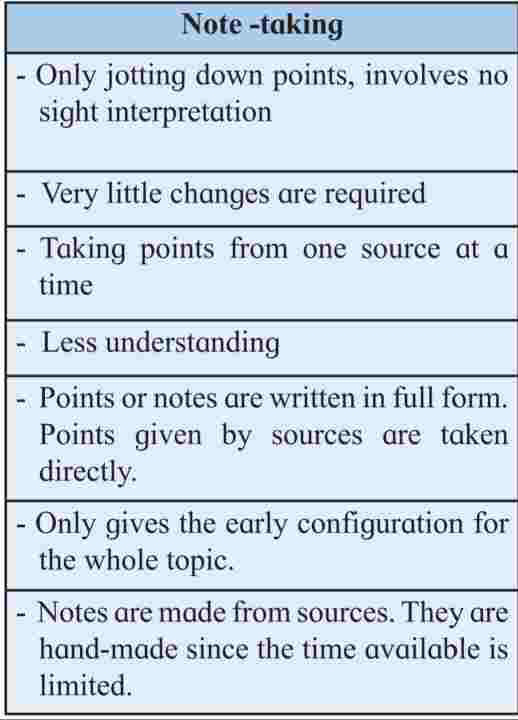Note-Taking and Note-Making
Both the skills are totally different.
• Note-taking is a passive process which is undertaken during lectures.
Note-taking at a glance gives a complete view of a paragraph or any
content which contains the main points and supporting details of what is heard
(during lectures or speech).
Taking notes while reading from different books and present for different
purposes.
• Note-making is a more active and focused ‘writing skill’ where a concretec
connection between all relevant concepts and words is drawn to infuse or connect
all thoughts together by a method. (points, tree diagram or a table etc.)
Similarities between Note-taking and Note-making
- - Both provide the students with material for easy reference, preparation and
- study during an examination.
- - Both aid the students in remembering facts easier as it utilizes both reading
- and listening senses.
- - Both have the same purpose, that is for the students to excel in their studies.
- - Both help the students to concentrate better and effectively.
Three stages of note making
Note making doesn’t only happen when you are reading or attending lectures. There are three stages making effective notes: before, during, and after.
- Before: Prepare by finding out what you need to know and what the purpose of the reading or lecture is.
- During: Note down main ideas and keywords. Find techniques that work for you.
- After: Reflect and review and then organise your notes.
NOTE-TAKING AND NOTE-MAKING
Styles of Note-Making
• Tables, Charts (Bar Charts, Pie Charts, Flow Charts), Line Graph, Tree
Diagrams, Pictograms, Maps and Plans
Ayurvedic Medicine Facts Fundamentals of Ayurvedic Medicine
To understand Ayurvedic treatment, it is essential to have an idea of how the
Ayurvedic system regards the human body. The basic life force in the body is prana,
which is also found in the elements and is analogous to the Chinese notion of chi. As
Swami Vishnudevananda, a yogi and expert, put it, “Prana is in the air, but is not the
oxygen, nor any of its chemical constituents. It is in food, water, and in the sunlight,
yet it is not vitamin, heat, or light-trays. Food, water, air, etc., are only the media
through which the prana flows.”
In Ayurveda, there are five basic elements that contain prana: earth, water, fire, air,
and aether. These elements interact and are further organized in the human body as 3
primary categories or basic physiological principles in the body that govern all bodily
process known as the doshas.
Note making explained | Note making | Library |
The three doshas are vata, pitta, and kapha. Each individual
has a unique blend of the three doshas, known as the person’s prakriti, which is the
reason why Ayurvedic treatment is always personalized. In Ayurveda, illness is regarded
as a state of imbalance in one or more of a person’s doshas, and an Ayurvedic physician
works to adjust and balance them, via a variety of methods.
The vata dosha is associated with air and aether, and in the body, promotes
movement agility. Vata people are typically thin and light physically, dry-skinned, very
energetic and mentally restless. When vata is out of balance, there are often nervous
problems, hyperactivity, sleeplessness, lower back pains, and headaches.
Note making explained | Note making | Library |
Pitta dosha is associated with fire and water. In the body, it is responsible for
metabolic processes and digestion. Pitta characteristics are medium-built bodies, fair skin,
strong digestion, and good mental concentration. Pitta imbalances show up as anger and
aggression and stress-related conditions like gastritis, ulcers, liver problems, and
hypertension.
The kapha dosha is associated with water and earth. People characterized as kapha
are generally large or heavy with more oily complexions. They tend to be slow, calm,
and peaceful. Kapha disorders manifest emotionally as greed and possessiveness, and
physically as obesity, fatigue, bronchitis, and sinus problems.




